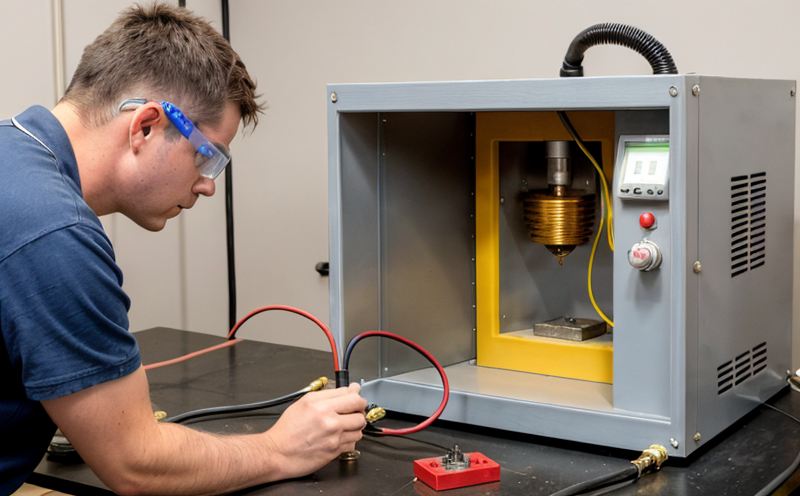ISO 2745 Conductivity Measurement of Aluminum Alloys
The ISO 2745 standard specifies a method for determining the electrical conductivity of aluminum and its alloys, which is crucial in ensuring quality control and compliance with industry standards. This testing procedure is widely used across various sectors where aluminum plays a critical role, such as aerospace, automotive, and construction.
Aluminum's unique properties make it indispensable in many industrial applications due to its low density, excellent thermal and electrical conductivity, high strength-to-weight ratio, and corrosion resistance. The measurement of electrical conductivity is essential for ensuring that the material meets specific performance requirements. This process involves precise sample preparation, careful calibration of instruments, and adherence to standardized protocols.
The testing procedure outlined in ISO 2745 involves preparing an aluminum specimen according to specified dimensions and tolerances. The specimen is then subjected to a controlled current through its cross-sectional area while measuring the voltage drop across it using a precision voltmeter. From this data, the electrical conductivity (σ) can be calculated using Ohm's law:
Formula: σ = I × A / V
- I: Current in amperes
- A: Cross-sectional area of the specimen in square meters
- V: Voltage drop across the specimen in volts
The result is reported in units of siemens per meter (S/m), which corresponds to the inverse ohm-meter. This value reflects how easily electrical current can flow through the material, providing insights into its purity and potential impurities.
Compliance with ISO 2745 ensures that aluminum products meet international quality standards, enhancing product reliability and safety in critical applications like aircraft structures or power transmission systems. Accurate conductivity measurements play a vital role in maintaining consistency throughout production processes and ensuring that end-users receive products that consistently perform as expected.
Understanding the importance of this measurement is key for industries relying heavily on aluminum's performance characteristics. For example, aerospace manufacturers need to ensure their components are not only lightweight but also maintain optimal electrical conductivity to function efficiently within complex systems.
Industry Applications
| Industry Sector | Application Examples |
|---|---|
| Aerospace Engineering | Verification of material integrity in aircraft components. |
| Automotive Manufacturing | Evaluation of electrical performance in battery systems and wiring harnesses. |
| Battery Production | Determining the quality of cathode materials used in lithium-ion cells. |
| Construction Materials | Safety checks on structural elements subjected to high current loads. |
- Aerospace Engineering: Ensuring the electrical integrity of wiring harnesses and components within aircraft systems.
- Automotive Manufacturing: Quality control in battery production for electric vehicles to ensure safe and efficient operation.
- Battery Production: Assessing the performance of cathode materials used in lithium-ion batteries, which directly impacts energy storage capabilities.
- Construction Materials: Evaluating the suitability of aluminum alloys for use in high-load-bearing structures where electrical conductivity is a critical factor.
The ISO 2745 method finds application across these sectors due to its ability to provide reliable and standardized measurements, thus promoting trust among stakeholders and facilitating regulatory compliance. By adhering to this international standard, manufacturers can ensure their products meet the highest quality standards required by industry norms and customer expectations.
Competitive Advantage and Market Impact
The ability to accurately measure electrical conductivity of aluminum alloys using ISO 2745 provides significant competitive advantages in several ways:
- Quality Assurance: Ensures that products consistently meet high-quality standards, reducing the risk of defects and recalls.
- Cost Efficiency: By identifying substandard materials early in the production process, manufacturers can minimize waste and avoid costly rework.
- Innovation: Provides a robust foundation for developing new alloys with enhanced performance characteristics.
- Regulatory Compliance: Ensures that all products comply with relevant international standards, opening up access to global markets.
In today's competitive market environment, where product reliability and compliance are paramount, accurate conductivity measurement is not just a technical requirement but also a strategic asset. It helps companies maintain their reputation for excellence while staying ahead of regulatory changes and customer expectations.
Use Cases and Application Examples
The ISO 2745 method finds extensive use in various applications across different sectors:
- Aerospace Engineering: Ensuring the electrical integrity of wiring harnesses and components within aircraft systems.
- Automotive Manufacturing: Quality control in battery production for electric vehicles to ensure safe and efficient operation.
- Battery Production: Assessing the performance of cathode materials used in lithium-ion batteries, which directly impacts energy storage capabilities.
- Construction Materials: Evaluating the suitability of aluminum alloys for use in high-load-bearing structures where electrical conductivity is a critical factor.
In each case, accurate measurement using ISO 2745 ensures that materials used meet stringent performance criteria. This not only enhances product reliability but also contributes to safer and more efficient operations across multiple industries.





